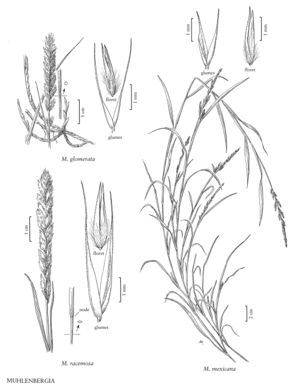Muhlenbergia glomerata
Plants perennial; rhizomatous, not cespitose. Culms 30-120 cm tall, 0.8-2.5 mm thick, erect, seldom branched above the base; internodes dull, mostly puberulent (sometimes sparsely so), terete, rarely keeled, strigose immediately below the nodes. Sheaths scabridulous, slightly keeled; ligules 0.2-0.6 mm, membranous, truncate, lacerate-ciliolate; blades 2-15 cm long, 2-6 mm wide, flat, usually scabrous or scabridulous, occasionally smooth. Panicles 1.5-12 cm long, 0.3-1.8 cm wide, lobed, dense; primary branches 0.2-2.5 cm, appressed; pedicels absent or to 1 mm, strigose. Spikelets 3-8 mm. Glumes subequal, 3-8 mm (including the awn), about 1.3-2 times longer than the lemmas, smooth or scabridulous distally, 1-veined, acuminate, awned, awns to 5 mm; lemmas 1.9-3.1 mm, lanceolate, pubescent on the calluses, mid-veins, and margins, hairs to 1.2 mm, apices scabridulous, acuminate, unawned or awned, awns to 1 mm; paleas 1.9-3.1 mm, lanceolate, loosely pilose between the veins, apices acuminate; anthers 0.8-1.5 mm, yellowish. Caryopses 1-1.6 mm, fusiform, brown. 2n = 20.
Distribution
Minn., Wash., D.C, Wis., W.Va., Conn., Mass., Maine, N.H., R.I., Vt., Wyo., N.J., N.C., N.Y., Pa., Nev., Va., Colo., Alta., B.C., Man., N.B., Nfld. And Labr. (Labr.), N.S., N.W.T., Ont., P.E.I., Que., Sask., Yukon, Ill., Ind., Iowa, Idaho, Md., Ohio, Utah, N.Dak., Nebr., Mich., Mont., Ky., Oreg., S.Dak.
Discussion
Muhlenbergia glomerata grows in meadows, marshes, bogs, alkaline fens, lake margins, stream banks, beside irrigation ditches and hot springs, and on gravelly slopes, in many different plant communities, at elevations of 30-2300 m. It is most common in southern Canada and the northeastern United States, but grows sporadically throughout the western United States. It is not known from Mexico.
Selected References
None.
